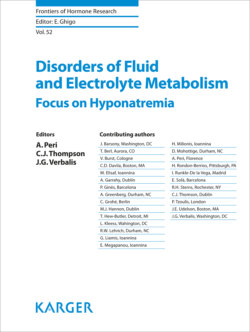Читать книгу Disorders of Fluid and Electrolyte Metabolism - Группа авторов - Страница 22
На сайте Литреса книга снята с продажи.
Water Balance
ОглавлениеKidneys are responsible for matching rates of water intake with water excretion, and they do it by the production of a concentrated or diluted urine. The components of normal external water balance are shown in Table 1.
There are 3 major sources of water intake: ingested liquids, the water that is present in solid food, and water produced by the oxidation of carbohydrates and lipids (metabolic water). The volume of ingested liquids is partially regulated by thirst but is frequently driven by thirst-independent drinking habits.
Water is lost by four routes: urine, sweat, feces, and insensible losses, but of these the most important mechanism by which water balance is achieved is the control of urine volume. Urine volume can be as low as 0.5 L/day during water deprivation, requiring urinary water retention, or as high as 18 L/day when water intake is equally high, for example, primary polydipsia. The volume of water in sweat varies according to physical activity and environmental temperature. Normally only a small amount of water is lost in stools, but this can be increased to several liters a day in patients with severe diarrhea. Insensible water losses are those by evaporation in the respiratory tract and skin. Metabolic water production matches the water lost by evaporation in the respiratory tract, so there is no net loss of water from respiratory insensible losses [6].
Table 1. Typical water balance
